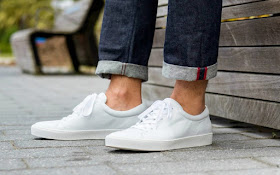The average consumer
discards up to 70 pounds of clothing and shoes every year. Most of this waste
ends up in landfills or incinerators. A number of footwear companies are
working toward decreasing the environmental footprint of womens and mens shoes
from manufacturing to disposal. Many sustainable styles are entering the
market, including a wide selection of sneaker styles. Find out more about five
sneaker sustainability trends.
The production of
waste starts with cast-off materials during the footwear manufacturing process.
Several leading brands are transitioning to circular rather than linear
production systems. Circular or closed-loop manufacturing involves the
elimination of all waste products.
In some cases, textile scraps or other left
over materials such as rubber for outsoles or foam for midsoles are used to
design new ladies footwear designs. These materials can also be scrapped to
produce pellets that are ready to use to make more of the original style or be
repurposed.
2. Recycled Materials
Several shoe
companies have incorporated recycled materials into footwear for years. Rubber
from tires or other sources have long been used to make the soles of women's white sneakers and other shoe styles. Other recycled materials such as plastic
and textiles are increasingly being reused to design shoes that are more
sustainable off of the manufacturing line.
3. Responsible
Sourcing
In the past, leather
sourcing for footwear rarely accounted for the conditions of production. Some
brands have begun featuring leather from environmentally conscious
gold-certified leather tanneries.
Even vegan leather alternatives have often
involved the use of toxic compounds such as aromatic amines, formaldehyde, harsh
dyes and phthalates. Virgin plastics have also historically been used to make
pleather and are often not recyclable at the end of the shoe lifespan. Sourcing
real leather and vegan leather alternatives more responsibly make shoes better
for the environment and safer for wearers.
4. Fair Trade
Materials and Manufacturing
In addition to the
quality of materials, the sustainability of shoes also depends on the treatment
of workers throughout the supply chain. The production of leather, rubber and
textiles and the manufacture of footwear under fair trade conditions may make
finished products slightly more expensive, but the added expense goes a long
way toward achieving sustainability.
5. Recyclable Designs
Shoes made out of
recycled materials are more environmentally friendly than footwear made with
virgin plastics, rubber and other new materials. Production is only one side of
the sustainability equation. Shoes that can be recycled or are biodegradable at
the end of the product lifespan helps to complete the cycle.
Even if these
materials are not directly repurposed into more shoes, reducing the number of
worn out shoes in landfills and incinerators is a big step toward reducing the
carbon footprint of sneakers.
Ongoing efforts to
reduce waste in fashion and footwear extend from design and manufacturing to
wear and disposal. On the production end, reusing materials, re-purposing
byproducts and eliminating other sources of waste allows for more sustainable sneakers. Concerned consumers should seek out shoe brands and designs that are
ethically made with recycled and recyclable materials.


No comments:
Post a Comment
Please Leave a Comment to show some Love ~ Thanks